Do you want to know how to write a blog post? Writing an effective blog post can somehow be difficult. But it can also be easy if you follow the right strategies.
If you want to start a blog or improve your blogging skills, this article is for you because we will go over how to write a blog post in detail, even if you are a beginner you can still understand it.
In today’s article, you’ll learn what a blog post is, what makes a good blog, the different types of blog posts, and some tips on writing an effective blog post that will drive a lot of traffic.
To help you navigate our detailed guide to writing an effective blog post, click on any of the methods we listed.
Ready? Let’s get started.
What Is A Blog Post?
A blog post is a written article (in a text format) or content piece that is published on a blog, usually in an informal or conversational tone.
Blog posts can cover many different types of topics or subjects, from personal experiences and opinions to informative articles and to product reviews, and so on.
As a blogger, blog posts are an important part of your blog because they allow you to share your knowledge, insights, and points of view with your readers.
Writing blog posts for your blog will allow you to showcase your expertise, provide helpful advice and tips, and engage in conversation with your readers.
What Makes A Good Blog Post?
What makes a good blog post is more than just using the right words, keywords, visuals, and so on; if you actually think such, you are mistaken.
A good blog post comes with a lot of other factors that contribute to the success of your blog. This includes how well it adds value and solves problems for your readers, how informative it is, and how well-structured it is.
Below are some basic and key elements of a good blog post:
Types Of Blog Posts
There are many types of blog posts that you can write and publish on your blog to engage with your readers, share your knowledge, and build a long-term presence.
You can also mix and match these different types of blog posts so that you can keep your content fresh and updated in the long term while you’re on the go.
Below are some of the most common types of blog posts:
1. How-to Posts
How-to posts are instructional articles that show you how to do something step by step or in a form of guides. These posts are usually very popular because they provide the reader with useful and actionable information.
These are some examples of how-to posts “How To Start A Blog,” “How To Become A Successful Blogger,” and “How To Get Traffic To Your Blog,”.
2. Opinion Posts
Opinion posts are articles in which the author expresses his or her opinion on a specific subject or topic. These types of posts can be very engaging and can inspire reader conversations and arguments.
These are some examples of opinion posts “Why I Quit My Job To Start Blogging,” “The Pros and Cons of Blogging,” and “Why Businesses Should Start Blogging“.
3. List Posts
List posts are articles that list a specific number of items, tips, or ideas about a specific topic. These posts are popular because they are simple to read and provide a quick overview of a particular subject.
These are some examples of list posts “10 Blogging Tips To Know Before Starting A Blog,” “10 Profitable Blogging Niche Ideas For Beginners” and “10 Ways To Make Money Blogging For Beginners“.
4. Interview Posts
Interview posts feature interviews with industry experts, influencers, or thought leaders. These posts offer unique insights and perspectives from people who have worked in a specific field.
These are some examples of interview posts “An Interview With A Successful Entrepreneur,” “Q&A With A Blogging Expert,” and “An Interview With A Pro Blogging Expert“.
5. Personal Experience Posts
These are articles that share personal experiences, lessons learned, or in a form of case studies. These types of posts are frequently very engaging and can help you in developing a strong connection with your readers.
These are some examples of personal experience posts “My Journey To 100K Subscribers,” “My Experience On Running Facebook Ads,” and “How I Was Able To Create A Successful Blog“.
Now that you understand the different types of blog posts, let’s look at some beginner-friendly tips for writing good blog posts.
How To Write A Blog Post
- Know Your Blog Audience
- Choose A Good Topic
- Do Keyword Research
- Create A Good Headline
- Create A Good Introduction
- Structure Your Post Content
- Write In A Conversational Tone
- Write Useful And Valuable Content
- Use Images For Visual Engagement
- Include A Clear Call To Action
- Add A Featured Image To The Post
- Edit And Check For Writing Errors
- Optimize The Post For SEO
- Publish Your Post (FINALLY)
1. Know Your Blog Audience
Knowing your blog audience is one of the most important things you can do as a blogger. Who are you going to write content for if you don’t know who your audience is?
Before you plan and start writing a new blog post, identify who your audience is and what type of content they prefer, as well as what you can write to solve their problems and so on.
Identifying and understanding your audience can help you in creating content that connects with them, engages them, and keeps them coming back for more.
It can also help you in customizing your writing style, tone, sense of giving values, and communicating their needs.
How To Know Your Audience?
The best way to know your audience and in better understand them is to choose your blogging niche. Your blogging niche is the topic or subject on which your blog focuses and on which you write content.
Choosing your blogging niche will help you in attracting a specific and targeted audience who shares your interest and concepts.
Your blogging niche can be broad or narrowed down, but it should be something about which you are passionate and that corresponds to your understanding, knowledge, and interests.
You can further analyze your competitors’ blogs to identify problems and opportunities in your blogging niche and strategies that work for them which you can implement in your blog to find your target audience.
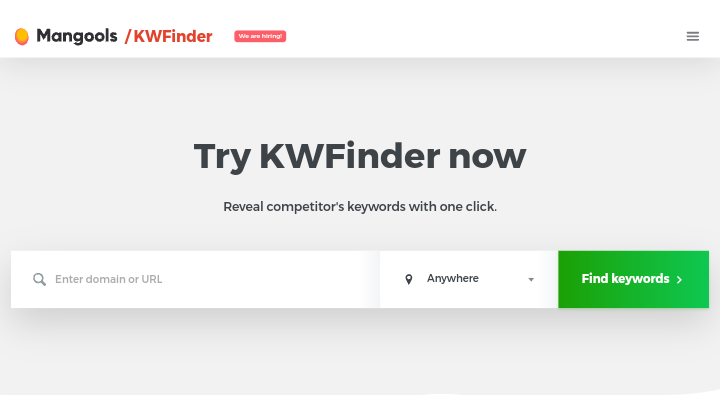
You can also use SEO tools like KWFinder, SEMrush, or Ahrefs to analyze your competitors’ traffic, content, backlinks, and keywords to see what matches up with their target audience and for you to find ways to differentiate yourself.
We have created and published a detailed guide on how to choose a blogging niche as well as profitable blogging niche ideas, which you should read by clicking here.
2. Choose A Good Topic
After you’ve identified your audience and blogging niche, the next step in writing a blog post is to come up with a good topic.
To come up with a good topic for your blog ask yourself this question; What are people searching for? What questions do they have? What problems are they trying to solve? If you know these things, I believe you will be able to come up with a good topic to write about.
Brainstorming is another great way to come up with new and good topics for your blog. Start by compiling a list of keywords or phrases related to your niche.

Then, based on those keywords, use tools like BuzzSumo, Google’s Keyword Planner, or Answer the Public to generate ideas. You can also look at social media trends or online forums to see what topics are getting a lot of attention.
You can also analyze your competitor’s blogs and see what topics they are writing content about. This will give you an idea of what topics are popular in your niche and the steps you can take to make difference.
You should also avoid writing about a topic that has already been widely published unless you can provide unique insight and more detailed information.
Because if a large number of blogs including your competitors have already written and published content on that topic, it might harm your search engine rankings and lead to placing your blog ranking position lower.
3. Do Keyword Research
You can’t just start writing the blog posts once you’ve come up with a good topic idea because you need to generate traffic to the blog post from search engines.
You need to do keyword research to see if the topic you want to write about on your blog can rank on search engines. This includes the number of people searching for the topic keyword and the difficulty in ranking for those keywords.
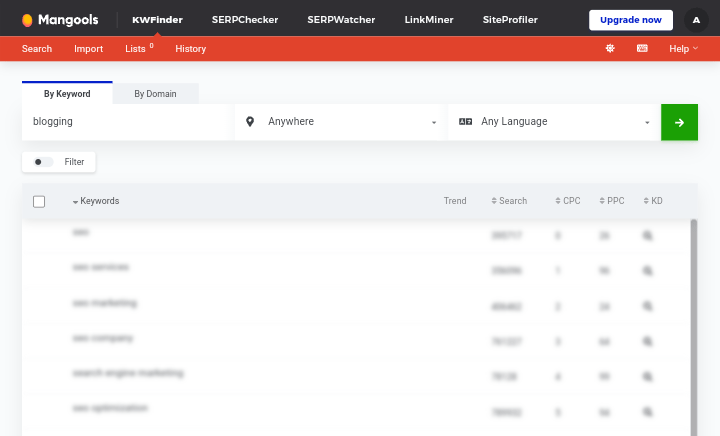
You can use keyword research tools like KWFinder, Ahrefs, and SEMrush, to help you find keywords related to your chosen topics and their search volume, competition level, and the estimated cost per click (CPC) for paid search advertising.
Alternatively, you can use Google to find keywords related to your chosen topics by going to Google and searching for them. Look at the title tags for the top-ranking pages as well for quick keyword ideas.
For example, if your blog is about a fitness blog, you can search for relevant topics on Google for Keywords like “healthy lifestyle,” “exercise routines,” or “healthy eating habits.”
When you scroll down to the bottom of the page, Google will automatically suggest keywords based on the topics you entered.
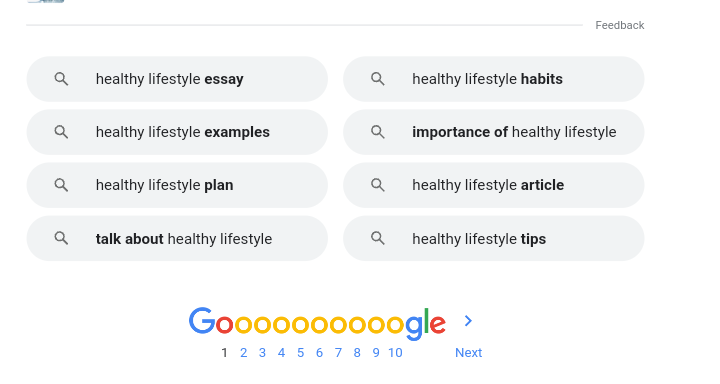
Using those keywords, you can identify which results are most closely related to the topic of your post and include them when writing.
4. Create A Good Headline
Now that you’ve chosen a good topic and done keyword research on it, what do you need to do next to create good headlines with the topic you’ve chosen?
The headline is the first thing readers see when they find your post via search engine results pages (SERPs) or on your blog, and it can influence whether or not they click through to read the rest of the article.
Stay away from using clickbait. Although creating and writing an engaging headline is important, it is also important to avoid using clickbait strategies that mislead readers or oversell the content of your post.
Your headline should accurately represent the content of your post and provide real value to your readers. Don’t promise your readers something in the headline that isn’t present in the post.
How To Create A Good Headline?
To create a good and engaging headline also known as a post title, consider using the following strategies:
Finally, don’t forget to test different headline variations to see what works best for your audience. To determine which headlines generate the most clicks and engagement, use tools like CoSchedule Headline Analyzer or BuzzSumo.
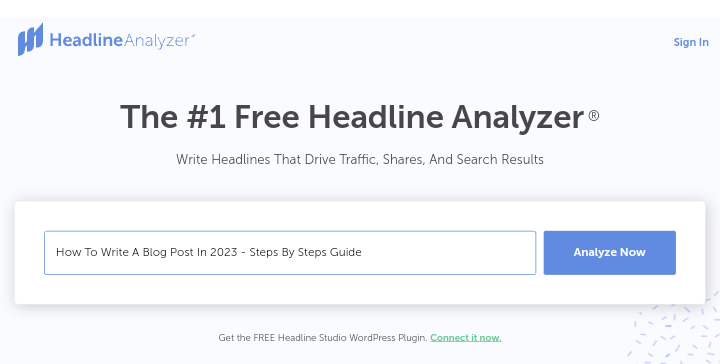
5. Create A Good Introduction
When writing your blog post, make sure to use a good introduction that grabs your reader’s attention, establishes the tone for your post, and provides a clear preview of what your post is about.
To write a good Introduction that hooks your readers, the first sentence you should write about in your introduction is usually the most important part. It should capture your reader’s attention and encourage them to keep reading.
To hook your readers and grab their attention in the right way, consider using a surprising fact, a thought-provoking question, a compelling observation, or a powerful quote at the beginning of the introduction.
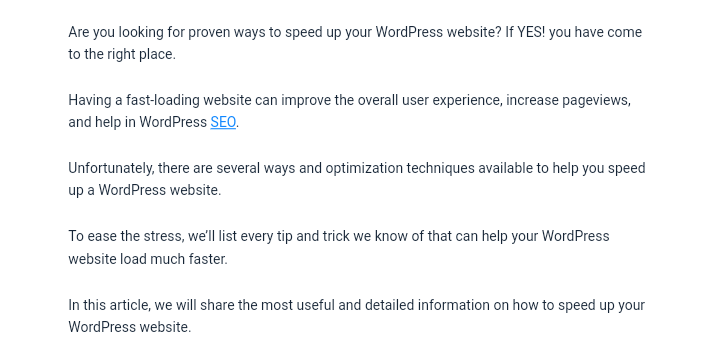
Also, include your targeted keywords in your introduction to help boost your post’s search engine rankings and make it easier to find by readers. Combine relevant keywords from your headlines or topic and put them in your introduction in a natural and organic way, without stuffing or forcing them in.
6. Structure Your Post Content
Structure your blog post content so that it is both readable and engaging. Your blog post should be well-organized so that your readers can be guided through the content and understand the main points of your post.
Break up your post into smaller sections with headings and subheadings to make it easier for readers to navigate your content. For easy readability, use descriptive titles that accurately represent the content of each section, and make sure to use a consistent structure of headings (such as H1, H2, H3, H4).
Use short paragraphs to structure your blog post, they are preferable to long paragraphs because they can be intimidating to readers and make your content appear crowded and difficult to read. The target is for 2-3 sentence short paragraphs and uses white space to break up the text and make it easier on the eyes.
Use lists, bullet points, and a table of contents to structure your blog post; these are great ways to present information in a clear and organized manner. Use them to break up long sections of text and highlight important points. Use the table of contents to direct readers to your post’s specific headings.
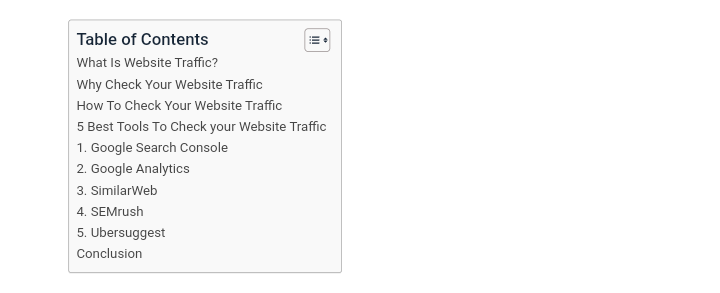
Finally, use a conclusion to summarize your main points and provide your readers with a clear description of what you have written so far in the post. Use your conclusion to wrap your post together and provide your readers with a call to action or next step.
7. Write In A Conversational Tone
Writing in a conversational tone makes your blog posts more engaging and friendly to your readers. It can help you in connecting with your readers and make your content more unique and relatable.
When writing, use contractions to achieve a more conversational tone because they are a natural part of spoken language. For example, instead of writing “do not” or “cannot” use “don’t” or “can’t” instead.
Use personal pronouns like “I” “you” and “we” when writing your blog post because it can help your writing sound more conversational and inclusive. It can also help you connect with your readers on a more personal level.
Avoid using Jargon or technical language in your writing to make it feel personal and simple to understand. Try to use clear and simple language and avoid slangs that your readers may not be familiar with.
As if you were speaking to a friend, write as if you were. Assume you’re having a conversation with a friend while writing your blog post. Write in a friendly and casual tone, as if you were explaining something to them in person.
Your readers will feel as if you are speaking to them one-on-one to support them in resolving a problem to which you can relate. A conversational tone is perfect for establishing and building a loyal audience.
8. Write Useful And Valuable Content
If you want to create a successful blog, the content you write in your blog posts should be useful and valuable to your readers. Your readers visit your blog because they want to learn something new, find answers to their questions, or solve a problem.
Take the time to learn about your readers’ wants, interests, and problems. This will help you in creating content that is both useful and valuable to them. And also make sure your content contains actionable information that your readers can put into practice or implement.
Writing useful and valuable content doesn’t mean writing long, complex blocks of text. Make your content easy to read by structuring it with headings, subheadings, bullet points, short paragraphs, and so on.
Most importantly, avoid copying other people’s blog posts and publishing them in your blog because this can result in duplicate content and search engines banning your blog. Instead, write your own content or use AI tools like Chatsonic to generate content ideas.
9. Use Images For Visual Engagement
Visual content can be in a form of screenshots, charts, illustrations, videos, and infographics. Screenshots are perfect for a “how-to” or “step-by-step” guide that shows actionable tips to help readers proceed through the content.
Including images, videos or screenshots in your blog posts effectively improves your reader’s engagement and helps them better understand your content.
Also, adding alt text to your images can help improve your blog’s visibility and search engine ranking. The alt text describes your image for readers when they are not fully loaded and can also help search engines better understand your content.
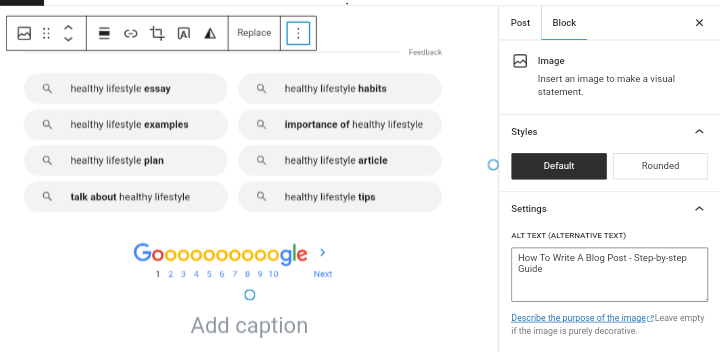
Keep in mind that large images can slow down your blog’s loading speed, which can have a negative impact on your readers’ experience. Make sure to compress and reduce the file size of your images before using them on your blog.
10. Include A Clear Call To Action
A call to action can help you achieve your goals of increasing reader engagement, growing your email list, or promoting a product or service.
A clear call to action is a statement that tells your readers what action they should take after reading your post. Should they subscribe to your newsletter or leave a comment? it’s left for you to decide.
Many bloggers usually use a call to action at the end of their blog post’s conclusion. A call to action can be used in a different format such as a button, text hyperlink, and plain text with no link.
Your call to action should be relevant to the content of your blog post. If you’re giving away a free guide or e-book, make sure it’s relevant to the topic of your post.
The following are the most common call-to-action (CTA) strategies used by bloggers:
To make your call to action (CTA) clear and compelling to your readers, use action-oriented words and sentences like “Subscribe Now“, “Try It For Free“, or “Download Your Free Guide“.
11. Add A Featured Image To The Post
The main image that represents your blog post is the featured image. It appears at the top of your post and is usually displayed on the homepage of your blog as well as in social media previews.
Your featured image should be related to the content and topic of your post. It should also be visually appealing and eye-catching in a way to attracts readers.
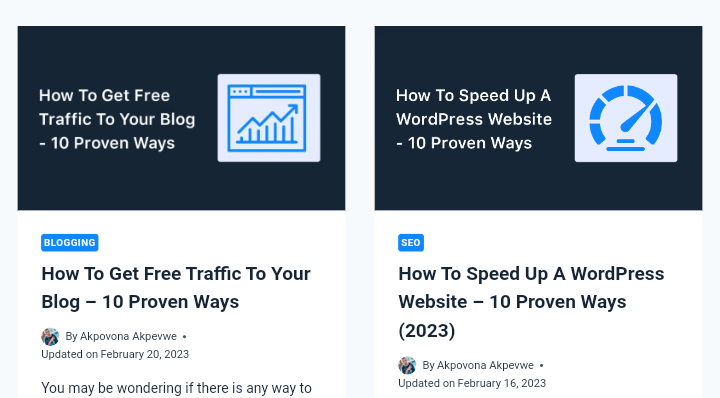
Consider how a featured image will fit into the overall design of your blog. Make sure that it complements the color scheme and style of your blog. WordPress recommends a featured image size of 1200 x 628 pixels.
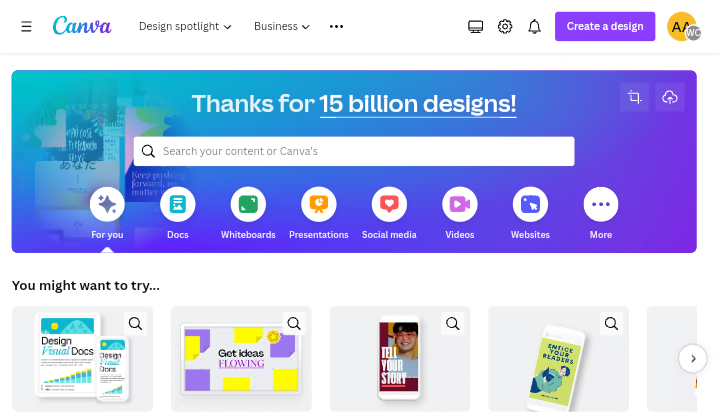
If you are looking to create an eye-catching and appealing featured image for your blog, you can use Canva for free.
12. Edit And Check For Writing Errors
To ensure that your blog post is error-free, double-check for any writing errors or mistakes. Even the best writers make mistakes, and these mistakes can decrease the overall quality and influence of your post.
You should read your post aloud to yourself. This can help you in detecting errors and identify strange or unclear sentences. To identify spelling errors, use your word processor’s spell-check function.
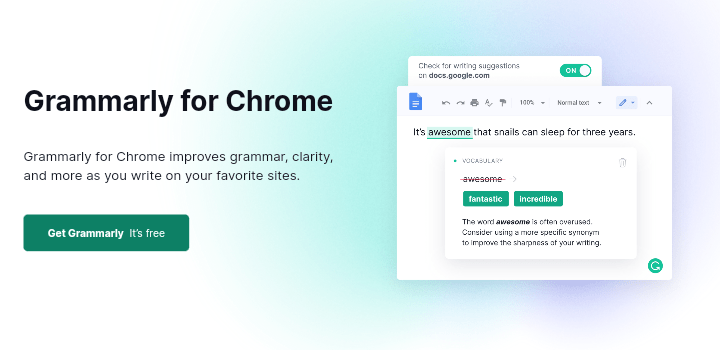
Or if you are using a laptop, you can install the Grammarly chrome extension to help you identify writing errors, grammar, and spell check, and show you how to correct them.
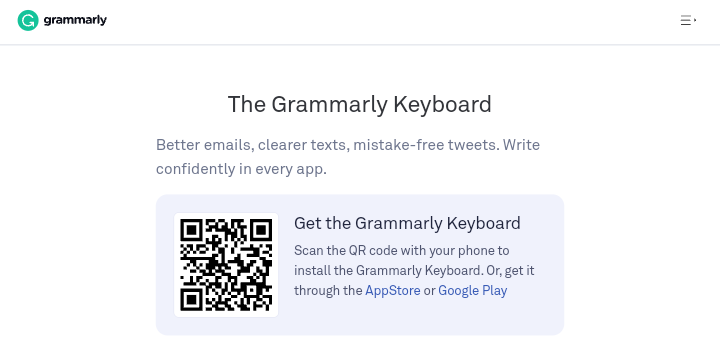
The Grammarly Chrome extension is free to use and install, and if you don’t have a laptop, you can install the Grammarly Keyword App from the Google Play store to help you with your writing in the same way that it will in the laptop version.
Recommend Reading: 10 Best Blogging Apps For Bloggers
13. Optimize The Post For SEO
Search Engine Optimization (SEO) is the process of improving the visibility of your blog post in search engine results pages (SERPs). You can increase the visibility of your post and attract more organic traffic to your blog by optimizing it for SEO.
There are different types of SEO you can implement in your blog to get more traffic to it, but in the best way before publishing your blog post make sure to do proper On-page SEO for it.
This includes using relevant and targeted keywords in your post title, headings, subheadings, and content of the post.
Linking to other relevant posts on your blog to improve navigation and provide additional value to visitors, and so on.
We have a separate guide on SEO best practices for bloggers to help you improve your Google rankings. You can read the guide to learn how you can do SEO for your blog.
14. Publish Your Post (FINALLY)
After you’ve finished writing and optimizing your blog post for SEO, the final step is to publish it so that visitors and your readers can access it.
But first, preview your post before publishing to ensure that everything looks as you want it to. Look for problems with formatting, spelling, broken links, and missing images. If there are any problems make sure to fix them before publishing.
If you are not ready to publish your post at that moment, you can schedule it for a later date and time. This is especially useful if you want to publish your post at a specific time or day in order to reach your targeted audiences.
Share your blog post on your social media account or pages once it has been published. This will boost the visibility of your post and bring more visitors to your blog.
If you’re looking for other ways to drive traffic to your blog, we’ve published a detailed guide on how to get free traffic to your blog, which you can read by clicking here.
Conclusion
This is how we write our own blog posts, and we believe that if you can follow these steps and implement them in your blog, you will be able to create a blog post.
You might also be interested in our list of the top 10 blogging tips and how to get blogging name ideas; if you’re ever stuck for blogging name ideas, this article will come in handy.
If you liked this article, please share it with others, especially those who are struggling to come up with blog post ideas and those who want to write their first blog post, and if you have any questions, please leave them in the comments section below.

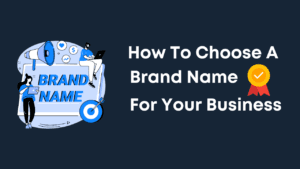

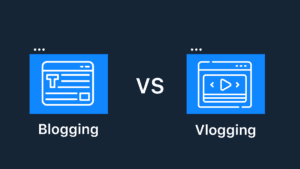



Special Web Hosting Offer | $2.99/mo